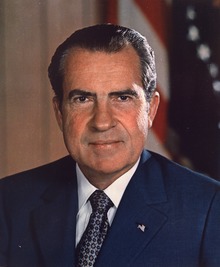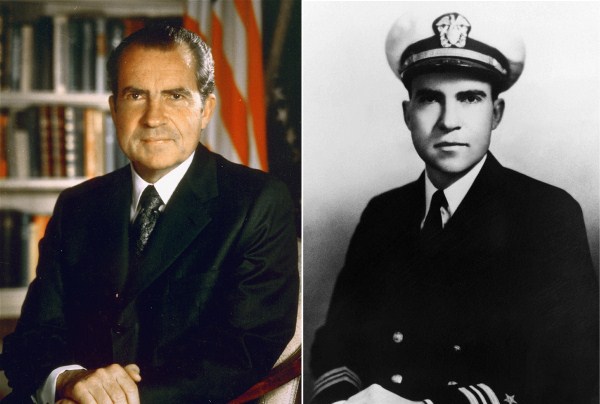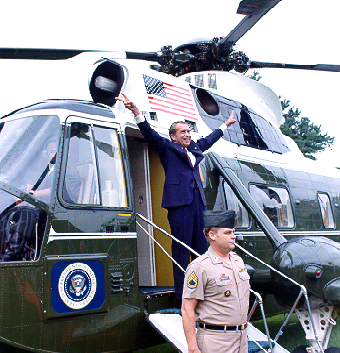President Richard Nixon; a quaker, a U.S. Navy vet, a politician, a President and the man at the heart of the notorious Watergate scandal. Nixon was the United State’s 37th President, and could be considered one of the most controversial Presidents of all time. Here are 10 interesting facts about Richard Nixon.

1. He Was a Quaker
President Nixon was raised a Quaker. The lifestyle was brought about by his mother, Hannah, who instilled her own beliefs in Nixon at a young age. When his father’s lemon grove was forced to close down in the early 1920s, the family moved to a Quaker community in Whittier, California. Here Nixon would attend Quaker meetings, up to four times on any given Sunday. Nixon went on to attend the town’s college, Whittier College, which was a Quaker school.
2. Joined the Navy During WWII
Because Nixon was a Quaker, he could have claimed an exemption from the draft and thus the military all together. Instead, he enlisted and was admitted in 1942 to the United States Navy as a Lieutenant Junior Grade. Nixon began his time in the Navy stationed in Iowa. He quickly switched positions to become the Naval Passenger Control Officer at the command center in the Pacific Theatre, and from there he moved around rapidly. Nixon would go on to become a commander in 1953; he retired from the Navy in 1966 and was on inactive duty from 1946-1966.

3. Received a Navy Letter of Commendation
While Nixon was the Officer in Charge of the Combat Air Transport Command at Guadalcanal in the Solomons, he (as well as his unit) received a Navy Letter of Commendation. This was given for the unit’s work preparing manifests, and flight plans for C-47 aircraft. The Navy Letter of Commendation is given to individuals for acts of heroism and meritorious service.
4. Ended The Vietnam War
When President Nixon entered office, the Vietnam War had been raging on for 14 years. The U.S. involvement in the war had escalated in the 1960s, and the country’s morale as a whole was low after more than a decade of fighting. Ending the war was one of Nixon’s campaign platforms and towards the end of his presidency he made good on that promise. Withdrawal occurred slowly, but by 1972 there were only 25,000 American troops left in Vietnam, and in January 1973 a peace treaty was signed. The United States agreed to withdraw from the land in exchange for their prisoners of war. It took just two weeks for troops to arrive back in America.
5. Authorized the Christmas Bombings
Prior to the peace treaty being signed in January of 1973, peace talks had stalled just one month earlier. It was December of 1972, when President Nixon authorized the bombing of ports and factories, as well as the Christmas Bombings. Some former POW’s claim this is one of the reasons for their freedom. The bombings of the ports and factories in December of 1972 are regarded as the largest bombings of the entire war. The second largest are the Christmas Bombing. The U.S. dropped bombs around Hanoi and Haiphong. In total, over 20,000 pounds of explosives were dropped on the cities over a several week period. The remaining POW’s that were encamped in the area said they could hear the bombs dropping on the cities.
5. Held a Dinner For the Final POW’S
Following the return of the last POW’s to leave Vietnam, Richard Nixon hosted a dinner for them at the White House. This was the largest dinner ever held at the White House, and included famous celebrities like John Wayne. The dinner was held on the White House’s South Lawn.
6. “Leader” of a Huge Re-election Scandal
June of 1972 is regarded as the beginning of the end for Nixon as a President. On June 17, 1972, peoples related to his election campaign broke in to the Watergate building (the Democratic Party’s headquarters) in Washington D.C. and were caught tapping phone lines, and stealing secret documents, among other things. It’s not known if President Nixon knew that it was going to happen prior to the event, but it is known he tried to cover the scandal up after the fact. He provided the burglars with money to stay quiet, fired staff members and even burned documents. While Nixon would get impeached, he would later be pardoned by his successor, President Gerald Ford.

7. Only U.S. President to Resign
Richard Nixon is the only U.S. President to resign from the position. The Watergate Scandal was coming down on Nixon, and it appeared he would be impeached soon. So in August of 1974, Nixon stepped down after nearly six years as President.
8. Lost His High School Presidential Race
While Nixon did lose his first run at Presidency, to John F. Kennedy, he managed to win his next two races for the President of the United States. But things were different for him on the election trail while growing up. In eighth grade, Nixon was elected President of his class. But just four years later, as a senior, he would go on to lose the race as President of his high school’s student body.
9. Time Magazine’s “Man of the Year”
In 1971, and in 1972, Time gave him the honor of being “Man of the Year.” This was due in large part to Nixon’s efforts in getting China into the United Nations, as well as attempting to get the United States and the Chinese government on better terms. He is the first U.S. President to have visited China.
President Nixon was no stranger to the Time Magazine cover; he appeared on the cover a total of 55 times.
10. Lee Harvey Oswald May Have Been After Nixon
The story begins post-Kennedy assassination. The Warren Commission (the group investigating JFK’s assassination) interviewed Lee Harvey Oswald’s wife, who said that in April of 1963, Oswald was reading the paper and said to her “Nixon is coming. I want to go and have a look.” At that moment, he was tucking a gun in to his pants. His wife then locked him in a bathroom and talked him down.
John F. Kennedy would be assassinated seven months later on November 22nd, 1963. Both Nixon and Kennedy were in Dallas that morning, however, Nixon left to go back to New York City before Kennedy’s motorcade went through Dallas. While it’s not known if any of this is linked together, it is known that Nixon was not visiting Dallas at that time, in April of 1963, and the newspaper had no mention of any future planned visits.